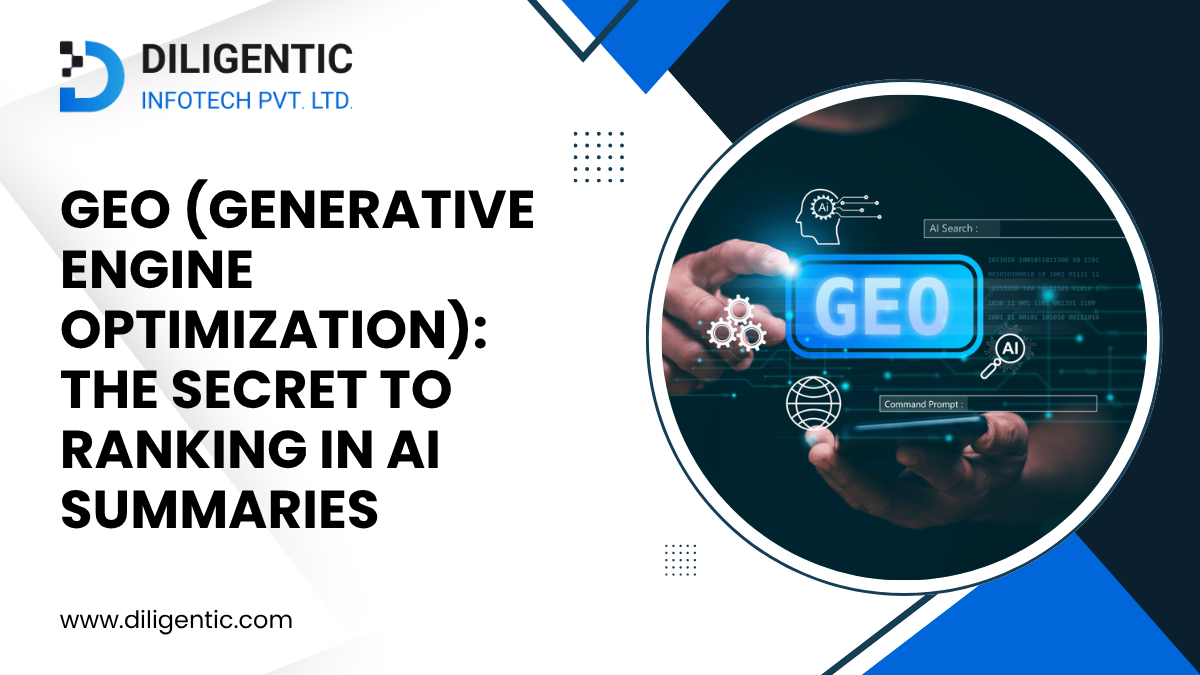SHARE

GEO (Generative Engine Optimization): The Secret to Ranking in AI Summaries

Generative Engine Optimization (GEO) is an emerging strategy for tailoring your content to perform well in AI-driven search platforms. It’s more than traditional SEO; it’s about shaping your articles, metadata, and structure so that AI summaries, generative AI SEO, and zero-click searches pull from and cite your website. This guide breaks down GEO versus SEO, shows how to design content that generative search optimization engines love, and gives actionable steps with examples to help your brand get featured in AI overviews and improve rankings.
Table of Contents
What is GEO?

Generative engine optimization refers to preparing your content so it’s selected, cited, and summarized by AI search tools such as Google AI summaries, ChatGPT, Perplexity AI, Gemini, and others. Unlike traditional SEO, which aims for search engine results pages (SERPs), GEO targets generative AI systems that produce “answer boxes” or zero-click searches. These AI tools ingest data from various sources to craft coherent summaries. If your content is organized effectively and demonstrates authority, it has the potential to be included in the summarized responses.
Why GEO Matters
AI Overviews Are Front and Center
AI-generated summaries often appear before any clickable result. Many users don’t click a result; they get their answers via zero-click searches. GEO ensures your content shows up in that snippet or summary.
SEO vs GEO: Not the Same
- Traditional SEO focuses on ranking your page on SERPs using backlinks, keywords, and meta descriptions.
- Generative engine optimization focuses on how AI models cite your content. This means clear facts, trustworthy citations, a concise layout, and a strong content structure.
Claims and Citations Matter
Studies show GEO can boost visibility in generative outputs by up to 40%. Including quotes, stats, bullet lists, or authoritative statements helps AI systems cite your work.
Generative AI SEO: The New Frontier
“Generative AI SEO” blends traditional keyword strategies with importance on content structure. Think:
- Short, simple sentences
- Headers like H2, H3
- Lists and tables for fast scanning
- Clear, authoritative signals and sources
- These features make content machine-friendly and easy for AI to include in summaries.
How Generative Search Optimization Works
- Content Crawling: AI uses retrieval-augmented generation (RAG) to scan large web content.
- Synthesis & Inclusion: Bots evaluate for clarity, authority, and format; well-organized, referenced content is more likely to be included.
- Answer Selection: During user queries, AI chooses the most relevant snippets; your content needs to stand out in clarity and context.
GEO vs SEO vs AEO vs AI Search Engine Optimization
| Focus Area | Traditional SEO | AEO (Answer Engine Opt.) | GEO (Generative Engine Opt.) | AI Search Engine Opt. |
|---|---|---|---|---|
| Main Goal | Rank on search results pages | Be featured in answer boxes | Be cited in AI-generated outputs | Optimize for AI systems overall |
| Content Style | Keyword-focused, dense text | Q&A style, designed for snippets | High authority, clear, often noted | Token-efficient and formatted |
| Metrics | Rankings, traffic, CTR | Featured snippets, voice results | Citation frequency in generative outputs | Retrieval rate, token usage |
| Examples Tools | Ahrefs, SEMrush, Moz | Schema, Q&A modules | AI EngineBoost, NLP tools, inline citations | AIO tools, vector optimizers |
The comparison reveals how GEO fits into a modern content strategy beyond ranking to being actively used by AI.
GEO Strategy: Step-by-Step Guide

1. Craft Content with AI in Mind
- Use descriptive subheadings (H2/H3) and bullet points to enhance readability and allow for quick scanning.
- Write short, factual sentences. Avoid fluff.
- Add quotes, data points, and citations. AI looks for evidence-backed content.
2. Use Metadata & Schema
- Add llms.txt or metadata tags to tell AI where key content resides.
- Include structured data (schema) for articles, FAQs, and lists.
3. Establish Authority
- Link to trustworthy sources.
- Include expert quotes or stats.
- Show both depth and breadth in coverage. AI favors reputable content.
4. Monitor AI Visibility
- Use Perplexity or Google Search Generative Experience to check if your content is cited.
- Track citation frequency in AI overviews; use tools like HubSpot’s AI Search Grader.
5. Keep Iterating
- GEO is evolving. Experiment with structure, citations, formatting, and metadata.
- Update content when AI engines change guidelines or release new features.
Real-World Example
Scenario: The IT firm Diligentic Infotech wants to rank for “custom mobile app development services.”
Traditional SEO: Write an in-depth blog targeting the keyword, optimize with internal/external links, and grow backlinks.
GEO-enhanced:
- Add a table comparing app platforms, development timelines, and tech stacks used.
- Include quotes: “Our cross-platform apps reduce development time by 40%”, supported by client project data.
- Use a structured FAQ like “What’s the difference between native and cross-platform app development?”
Outcome: The AI summary might state:
“Diligentic Infotech’s mobile app services cut development time by 40% with cross-platform solutions.”
…referencing their blog in the generative overview.
Why GEO Will Matter More

- More zero-click searches: 40% of users get answers without clicking, and 80% complete searches without site visits.
- AI-first search: Tools like ChatGPT and Gemini now handle billions of queries weekly.
- Brand narrative control: By ranking in summaries, you shape perceptions directly. Without GEO, you’re invisible in AI-driven dialogues.
Bonus Tips
- Watch AI trends & tools: Tools like HubSpot’s AI Search Grader and Alli AI help analyze GEO readiness.
- Blend with traditional SEO: Use a hybrid strategy, maintain a strong Google ranking, AND appear in AI summaries.
- Think long-term: Keep updating citations and metadata as models evolve; the goal is sustained visibility.
If you want to know more about What Is Performance Marketing?, check out our detailed blog.
Conclusion
Generative Engine Optimization is a clear step beyond traditional SEO. GEO focuses less on ranking links and more on shaping AI search summaries, helping your brand appear in zero-click answers. By structuring content well, using citations, metadata, and FAQs, and monitoring AI visibility, you improve your chances of being cited by ChatGPT, Gemini, Perplexity, and others.
Want to talk more about GEO strategies, AI search engine optimization techniques, or how to blend SEO, AEO, and GEO in your marketing? Let’s talk at Diligentic Infotech; we help brands own the AI-powered future.
FAQs
What is GEO?
GEO (Generative Engine Optimization) helps high-quality content get cited in AI-generated answers.
Is GEO the same as SEO?
Not exactly. GEO builds on SEO by focusing on citation in AI responses. SEO aims for link ranking, and GEO aims to be quoted in generative answers.
Is GEO only for big websites or brands?
No, any site with clear and useful content can be picked up by AI if it’s well-structured.
Will GEO help me rank on Google too?
It helps your content show up in AI answers, but traditional SEO still supports Google ranking.
Why is GEO important?
It boosts brand visibility in AI-generated summaries and answers.
Engage with our experts
Subscribe to our newsletter!
Be the first to get exclusive offers and the latest news.
Posted on 25 Nov 2025
7 SEO Changes You Can’t Ignore in 2026: And How to Leverage Them
By 2026, the SEO landscape will shift dramatically. If your approach hasn’t evolved, you’ll lose organic visibility. The key seven changes you can’t ignore are: AI-answer optimization, enhanced E-E-A-T signals, zero-click behaviour, video and forum search expansion, personalized search paths, local/social search convergence, and deep technical hygiene. Whether you’re a brand, a digital marketing company […]
Posted on 20 Nov 2025
Posted on 6 Nov 2025
7 Benefits of Outsource SEO Services for Businesses in 2025
Outsource SEO services allows businesses to access expert skills, lower costs, and adapt flexibly to changing needs. Outsourcing SEO frees internal resources, speeds up implementation, and uses advanced tools for better rankings and local SEO impact. It scales with your business, avoids the overhead of in-house teams, and brings proven, up-to-date strategies for consistent growth.

Reach out
Let’s Start Together
We're a collective of high caliber designers, developers, creators, and geniuses. We thrive off bouncing your ideas and opinions with our experience to create meaningful digital products and outcomes for your business.
Phone Number
+1 (825) 760 1797
hello[at]diligentic[dot]com
